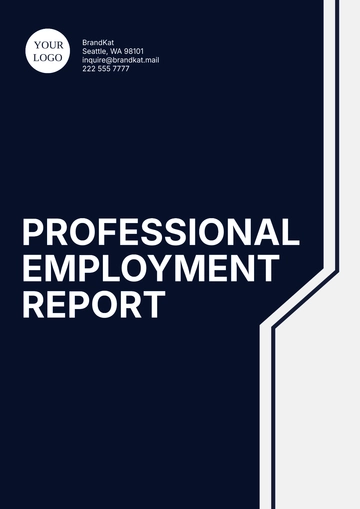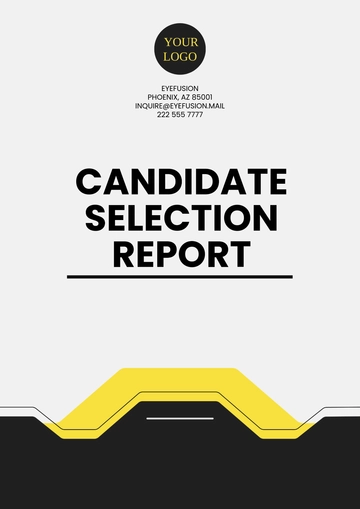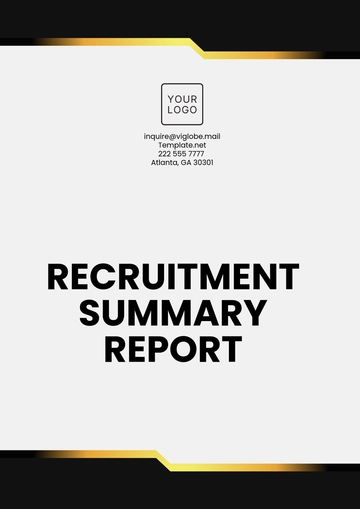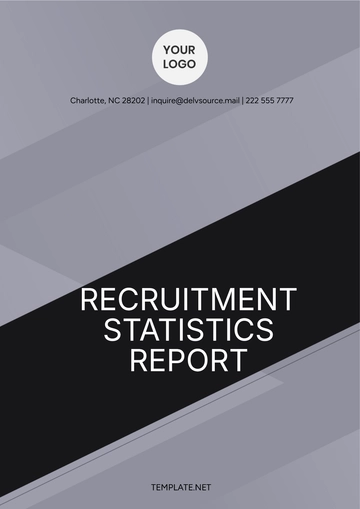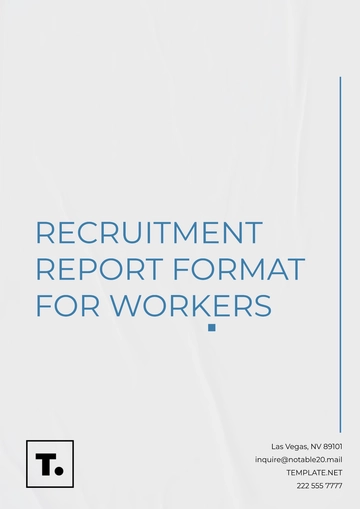Free Recruitment Report

This Recruitment Report provides a detailed analysis of the recruitment process for the period of Q3 2051, highlighting key metrics, challenges, and outcomes. The purpose of this report is to evaluate the effectiveness of the recruitment strategies, provide insights into candidate sourcing, and offer recommendations for future improvements.
Executive Summary
The recruitment efforts for Q3 2051 were focused on filling key roles across multiple departments, including IT, marketing, and sales. This report examines recruitment activities, including the number of applicants, time-to-hire, and the diversity of candidates sourced. The primary goals for this period were to reduce the time-to-hire by 15% and improve the candidate experience.
Key highlights:
Total number of hires: 50 new employees across 12 different departments
Time-to-hire: Reduced by 12% compared to Q2 2051
Cost per hire: Increased slightly by 5% due to investment in more targeted job advertising
Diversity: 45% of new hires identified as female, 30% as ethnic minorities
Recruitment Objectives
The key objectives of the recruitment process for Q3 2051 were:
Reduce time-to-hire by 15% compared to the previous quarter.
Enhance candidate quality by sourcing candidates with higher qualifications and skill levels.
Improve diversity by ensuring a more inclusive hiring process.
Streamline the recruitment funnel to reduce bottlenecks during screening and interview stages.
Recruitment Metrics
The following table outlines the key metrics for the recruitment period in Q3 2051, providing insights into the overall efficiency and effectiveness of the recruitment process.
Metric | Q3 2051 | Q2 2051 | % Change |
|---|---|---|---|
Total Applicants | 1,200 | 1,100 | +9.09% |
Total Hires | 50 | 45 | +11.11% |
Time-to-Hire (Days) | 30 | 34 | -12% |
Cost per Hire | $3,000 | $2,850 | +5.26% |
Interview-to-Offer Ratio | 3:1 | 4:1 | -25% |
Candidate Sourcing Channels | |||
- Job Boards | 40% | 35% | +5% |
- Employee Referrals | 25% | 30% | -5% |
- Social Media | 20% | 15% | +5% |
- Recruitment Agencies | 15% | 20% | -5% |
Observations:
The increase in applicants (9.09%) was driven by enhanced job posting strategies, especially on social media.
Time-to-hire improved by 12% through process optimizations such as pre-screening automation and better scheduling of interviews.
There was a slight increase in the cost per hire (5.26%) due to the use of premium job boards and targeted ads for high-skill roles.
Source of Candidates
A significant portion of the candidates came through various sourcing channels. Below is a breakdown of where the candidates were sourced.
Sourcing Channels:
Job Boards:
Increased investment in paid ads on top job boards led to a 5% increase in applicants sourced through this channel.
Job boards remain the most consistent source of candidates, providing a steady stream of applicants for a wide range of roles.
Employee Referrals:
A 5% decrease in employee referrals can be attributed to a lack of active internal referral campaigns during this period.
While referrals have decreased, they remain one of the highest quality sources, as these candidates tend to align well with the company culture.
Social Media:
The use of targeted campaigns on LinkedIn and other professional networks saw a 5% increase in candidates from this channel.
Social media is particularly effective for sourcing candidates for marketing and technology positions.
Recruitment Agencies:
Although recruitment agencies provide specialized candidates for niche roles, their share in total hires decreased by 5% as the internal recruitment team took a more proactive approach.
Candidate Demographics
The demographic breakdown of the candidates hired in Q3 2051 is as follows:
Gender Diversity:
Female: 45%
Male: 55%
Ethnic Diversity:
Caucasian: 40%
Hispanic/Latino: 25%
Black/African American: 20%
Asian: 10%
Other: 5%
The diversity of candidates hired aligns with the company’s diversity goals, which included a focus on ensuring equitable opportunities across all departments.
Recruitment Process Overview
The recruitment process in Q3 2051 followed a structured, multi-step approach aimed at ensuring the highest quality candidates are selected.
Stages:
Job Posting and Sourcing:
Job descriptions were posted across multiple platforms, including LinkedIn, Glassdoor, Indeed, and social media channels.
Screening:
Initial resume screening was automated using AI-powered software to filter candidates based on specific keywords and qualifications.
Interviewing:
Initial Screening: Conducted via video interviews to assess soft skills and cultural fit.
Final Interviews: In-person interviews were held for short-listed candidates to evaluate technical skills and role-specific competencies.
Offer and Onboarding:
Offers were extended to the top candidates, and the onboarding process was streamlined using digital tools to ensure a smooth transition for new hires.
Bottlenecks Identified:
The main bottleneck occurred during the interview scheduling phase, where candidates experienced delays due to conflicting availability. To improve this, an automated scheduling system will be implemented in the next quarter.
Challenges and Solutions
Challenges:
Delayed Interview Scheduling: Scheduling conflicts led to a longer-than-expected time-to-hire.
Diversity: Although the gender diversity was strong, ethnic diversity could be improved in certain departments like IT and Engineering.
Solutions Implemented:
Automated Scheduling: The introduction of an automated scheduling system helped streamline the interview process.
Targeted Sourcing: To address diversity gaps, recruitment campaigns were specifically tailored to target underrepresented groups, particularly in IT roles.
Outcome and Results
Total Hires:
A total of 50 hires were made, with the highest demand in IT (18 hires), Sales (12 hires), and Marketing (10 hires) departments.
Position Fill Rate:
100% of positions in Sales were filled, while there was a 70% fill rate in Engineering due to a shortage of qualified candidates in the local market.
Recommendations
Based on the analysis, the following recommendations are made for improving the recruitment process in Q4 2051:
Increase Investment in Diversity Recruitment: Focus on diversifying sourcing channels and improving outreach to underrepresented communities, especially in technical roles.
Enhance Candidate Engagement: Implement more personalized communication with candidates to reduce drop-off rates between interviews and offers.
Optimize Interview Scheduling: Use automated tools to help streamline the interview scheduling process and improve time-to-hire metrics.
Conclusion
The recruitment efforts in Q3 2051 were generally successful, with notable improvements in time-to-hire and applicant quality. However, challenges remain in diversifying the candidate pool and reducing bottlenecks in the interview phase. By implementing the recommendations, the recruitment process can continue to improve, ensuring that future hires align with organizational goals and talent needs.
- 100% Customizable, free editor
- Access 1 Million+ Templates, photo’s & graphics
- Download or share as a template
- Click and replace photos, graphics, text, backgrounds
- Resize, crop, AI write & more
- Access advanced editor
Streamline your hiring process with Template.net's Recruitment Report Template—fully editable and customizable to meet your team’s needs. Designed for seamless integration, this template is compatible with our AI Editable Tool, making it easy to tailor reports with precision. Save time and present professional, data-driven insights effortlessly with this versatile recruitment solution.
You may also like
- Sales Report
- Daily Report
- Project Report
- Business Report
- Weekly Report
- Incident Report
- Annual Report
- Report Layout
- Report Design
- Progress Report
- Marketing Report
- Company Report
- Monthly Report
- Audit Report
- Status Report
- School Report
- Reports Hr
- Management Report
- Project Status Report
- Handover Report
- Health And Safety Report
- Restaurant Report
- Construction Report
- Research Report
- Evaluation Report
- Investigation Report
- Employee Report
- Advertising Report
- Weekly Status Report
- Project Management Report
- Finance Report
- Service Report
- Technical Report
- Meeting Report
- Quarterly Report
- Inspection Report
- Medical Report
- Test Report
- Summary Report
- Inventory Report
- Valuation Report
- Operations Report
- Payroll Report
- Training Report
- Job Report
- Case Report
- Performance Report
- Board Report
- Internal Audit Report
- Student Report
- Monthly Management Report
- Small Business Report
- Accident Report
- Call Center Report
- Activity Report
- IT and Software Report
- Internship Report
- Visit Report
- Product Report
- Book Report
- Property Report
- Recruitment Report
- University Report
- Event Report
- SEO Report
- Conference Report
- Narrative Report
- Nursing Home Report
- Preschool Report
- Call Report
- Customer Report
- Employee Incident Report
- Accomplishment Report
- Social Media Report
- Work From Home Report
- Security Report
- Damage Report
- Quality Report
- Internal Report
- Nurse Report
- Real Estate Report
- Hotel Report
- Equipment Report
- Credit Report
- Field Report
- Non Profit Report
- Maintenance Report
- News Report
- Survey Report
- Executive Report
- Law Firm Report
- Advertising Agency Report
- Interior Design Report
- Travel Agency Report
- Stock Report
- Salon Report
- Bug Report
- Workplace Report
- Action Report
- Investor Report
- Cleaning Services Report
- Consulting Report
- Freelancer Report
- Site Visit Report
- Trip Report
- Classroom Observation Report
- Vehicle Report
- Final Report
- Software Report




